After a rough four hours of sleep, I woke up at 2:30 and requested an Uber. Our apartment was on an alley, and both Uber drivers we ever had both had problems finding the place. All in all we were on our way to the market at 2:45am, and arrived at 3am. Most taxi or Uber drivers should know where to drop you, but it’s worth mentioning that you want to be dropped at the fish auction line. The line wasn’t huge, but not small either, but we lucked out and got into the first group. There are two tours, and people are assigned times on a first come, first serve basis. We were corralled into a small room, with no chairs, benches, or anywhere to sit at 3:15. The tour starts at 5:25. After about twenty minutes of sitting on the floor, bumping elbows and fighting for leg space among other tourists, a handful of people, including myself, decided to walk out and be outside. Granted, it was air-conditioned inside but outside we could stretch out. Vests are handed out before we were herded into the waiting room, so we weren’t losing our spot in line for the tour.
At around 5:20, we headed back into the room and followed the guard through Tsukiji Market. I would highly recommend the tour; it’s breathtaking to watch the whole market operate at once, especially in the parts normal visitors aren’t allowed to see. We were led into the auction room, with a watching area partitioned out in the middle of the room. Before the actual auction, each buyer would approach a fish and inspect it for quality. Each fish’s tail is cut off so the fatty meat can be observed. Some buyers also used picks and began chopping into the fish, although I’m not sure what they guage from that

.
The auction began soon after that, with bells ringing and quite a bit of screaming. I wasn’t exactly too sure who was winning, but it was certainly fascinating to watch

. After each auction (I suppose) an auctioneer came around and painted the name of the highest bidder on each fish, which were then hauled out by the buyer.
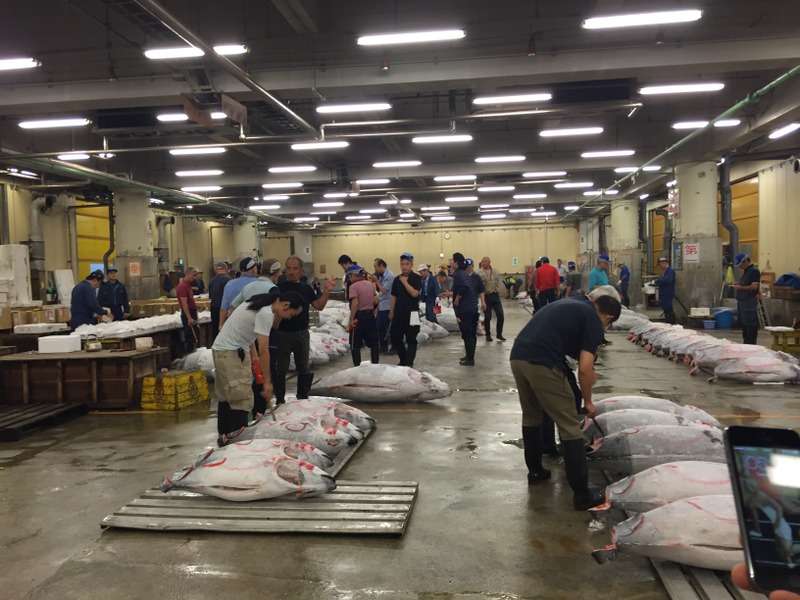 Fish Auction
Fish Auction
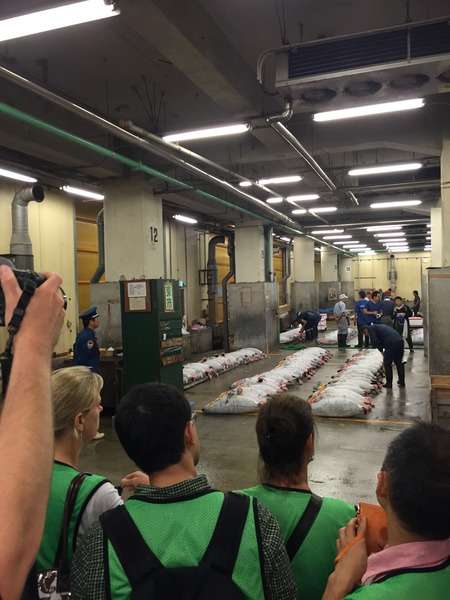 Fish Auction
Fish Auction
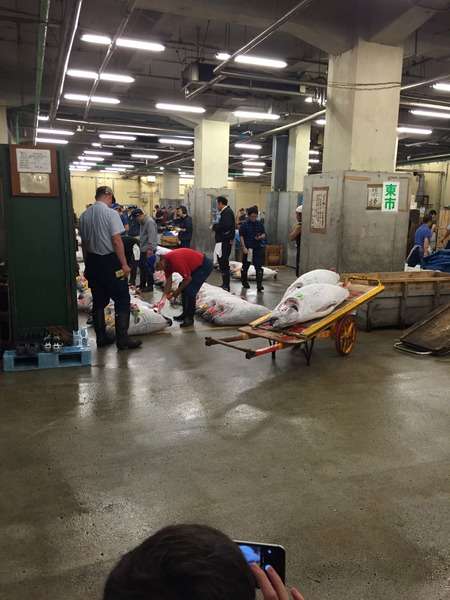 Fish Auction
Fish Auction
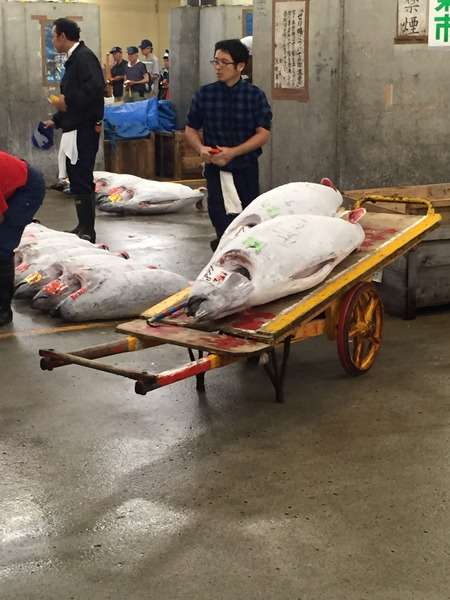 Fish Auction
Fish Auction
After the auction, we were led, once again, through the wholesale are of the market, and I spotted what looked like one of the fish that was at auction!
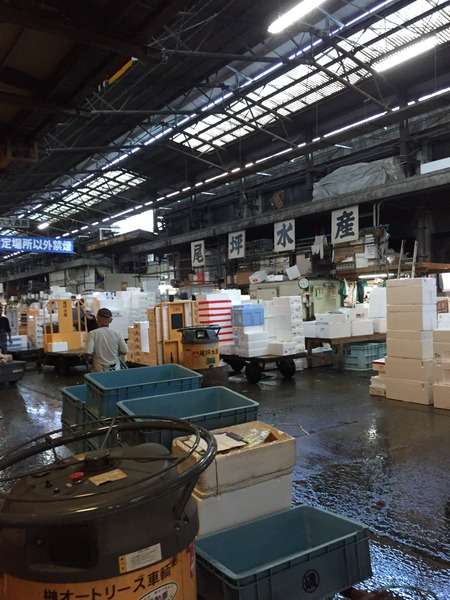 Tsukiji Wholesale Area
Tsukiji Wholesale Area
 Tuna
Tuna
Towards the end the group got split up due to the unpredictable “traffic patterns”

. We were also walked past the enormous pile of Styrofoam containers, which has been covered in other Tsukiji reports. (I don’t have a picture). I very much enjoyed the auction, and it's a must see for visitors to Tokyo! The tour lasted about 35 minutes, and from there, my travel companion and I decided to find some breakfast in the market.
 Tsukiji
Tsukiji
Having had sushi the day before, we thought we’d try something different. We had heard about a place serving up steamed fish online, so we figured we’d check it out. There was no line and we were originally turned away from the line because they don’t have an English menu. We showed them the picture of the dish we wanted from the article and they begrudgingly let us in. First and foremost, my partner was served the fish head, and I was served the tail. The food was ok, but we really had no clue what fish we were eating, or how to properly eat it. The real shocker came at the end, when we were quoted a ridiculous 4000 yen for both of us (we didn’t order any drinks). Not wanting to argue considering we hadn’t actually seen the price on the menu, although there’s no way locals pay that much, we paid up and high-tailed it out of there.
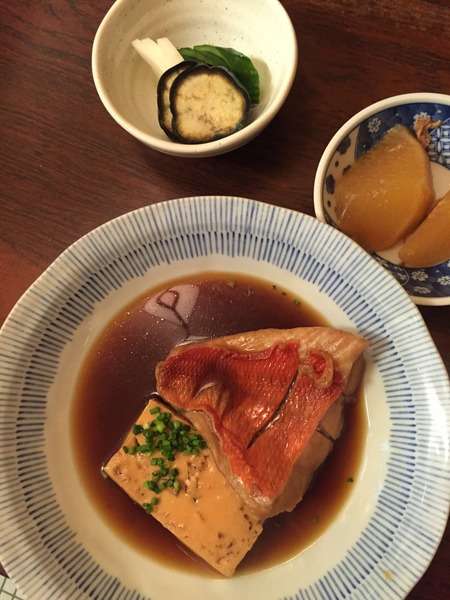 Breakfast
Breakfast
After such an early start, we decided to head back to Shibuya to rest for a couple hours and pack for Aomori. We got back around 8:30 and our bullet left Tokyo at 11:16, so we figured we’d be good in terms of timing.
Now, let me explain our poor planning in this case. We had planned our visit to Hokkaido about a month or so before departure, so I pulled the trigger on some ~$180 r/t tix to Sapporo August 6th through the 8th. However, we hadn’t discovered Aomori until about 3 days before departure, when we made the decision of getting the JR Pass for 14 days instead of 7 days (more on that after this paragraph). The Nebuta Matsuri festival was on the night of the 4th, and we couldn’t cancel our Sapporo tickets. Aomori is a four hour bullet train ride north of Tokyo, and from there it was a 6-hour crawl to Sapporo, which is even farther north. But ultimately, our schedule had us going up to Aomori on the fourth, returning the fifth to Tokyo, and leaving the next day for Sapporo, which was pretty hectic. Here’s that on a map, using GCMap:
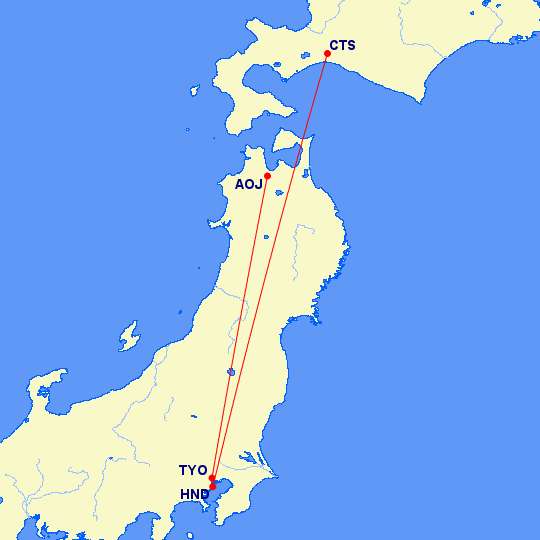 Map of Japan
Map of Japan
Instead of lugging our carry-ons and personal items around the country, we packed a single backpack and left our stuff at the Tokyo pad (which we were forced to keep for the extra night as well). We booked the last hotel room in Aomori for $244 last-minute, at the Hotel Sunroute Aomori, which was the most spotless yet rundown hotel I’ve ever been to.
About the JR Passes: a 7-day pass currently costs $231, and a 14-day pass costs $368, ordering through Jrpass.com. The pass is only available to foreigners and worth every penny. The company mails you an exchange order, which is exchanged in Japan for a pass. The pass can then be presented at any ticket gate, and you can walk onto any train. However, for Shinkansen, most of which are reserved seats only, a visit to the ticket office is required, and the seat tickets are issued for free and checked on the train. It’s worth noting that the Shinkansen tickets, and any other reserved tickets for that matter, are NOT for use in automatic ticket gate, which will cause confusion and embarrassment at the train station. The 7-day pass is the same price as a roundtrip ticket to Kyoto, which we were visiting during the second week of our trip, but getting the pass instead allows virtually unlimited flexibility for other train trips. Had we not gone to Aomori, we would have gotten the 7-day pass. The pass ultimately saved us at least 7100 yen (about $65), although it would have saved us 21,000 yen, (around $180) had I not had a, erm, incident regarding the pass, which will be covered in “My most embarrassing travel mistake ever.” I would get the pass again in a heartbeat
if when I return to Japan

.
We ended up napping a little too long, and got on the 10:48am train, getting in around 11:11, 5 minutes before our train, so we were sweating the whole way to Tokyo station.
We figured our transfer would be easy, painless, a piece of cake. After all, Shinkansen depart
at the time published, not like aircraft, where the door closes 10 minutes before departure. I will just say for the record that Tokyo station is a complete cluster, especially at the Shinkansen transfer gates. All I can recommend to those transferring at Tokyo station is to be brave and don’t stop walking. It was a complete flood of people, everywhere we turned. The most challenging part are the structural columns, which obstruct all views of oncoming traffic. Needless to say, the very thought of transferring/terminating/storing bags/etc. (all things we did) gets my blood pressure up. Either way, we made it to our Shinkansen with two minutes so spare, and we settled into our seats. Having been operating on eight hours of sleep in the past 48 hours, I passed out for most of the journey, but I will say that the train was comfortable, quick, and without a doubt one of the more exciting everyday experiences we had in Japan.
Next up: Arrival at Shin-Aomori and Nebuta Matsuri!